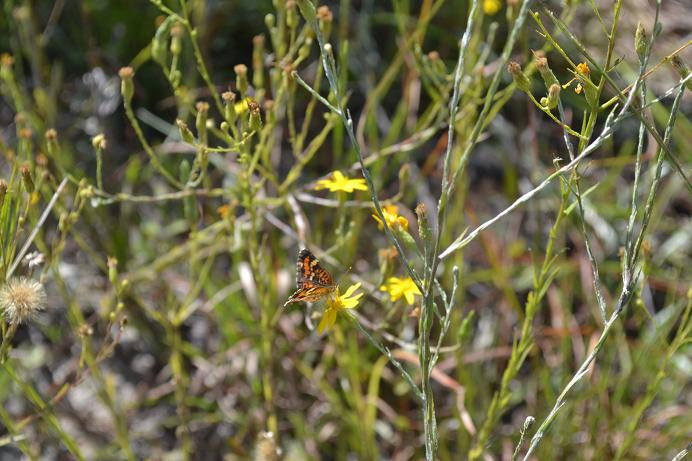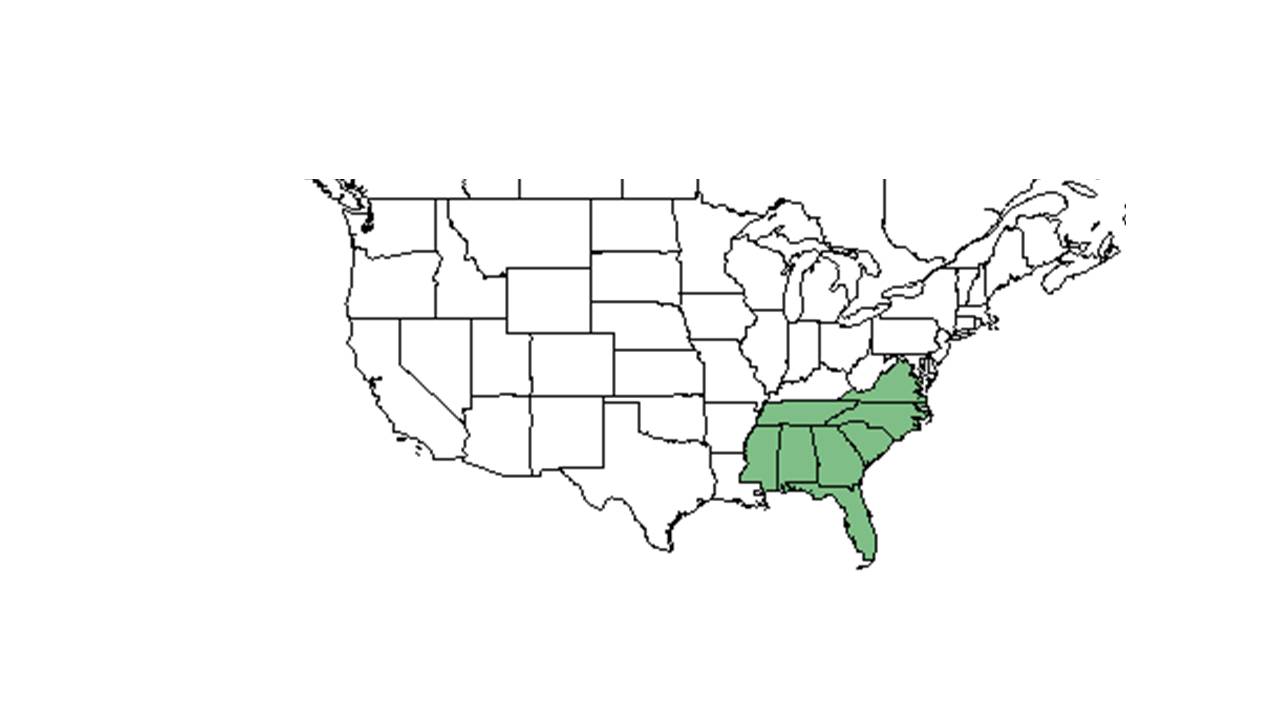Difference between revisions of "Pityopsis aspera"
Krobertson (talk | contribs) |
Krobertson (talk | contribs) |
||
| Line 30: | Line 30: | ||
==Ecology== | ==Ecology== | ||
===Habitat=== <!--Natural communities, human disturbed habitats, topography, hydrology, soils, light, fire regime requirements for removal of competition, etc.--> | ===Habitat=== <!--Natural communities, human disturbed habitats, topography, hydrology, soils, light, fire regime requirements for removal of competition, etc.--> | ||
| − | ''P. aspera'' is distributed across southern Georgia and northern Florida <ref name="Gowe and Brewer 2005">Gowe, A. K. and J. S. Brewer (2005). "The evolution of fire-dependent flowering in goldenasters (Pityopsis spp.)." Journal of the Torrey Botanical Society 132: 384-400.</ref> and is commonly found in Florida sandhill community <ref name="Downer 2012"/> Habitats documented include longleaf wiregrass sandhills, deep sand banks along hardwood hammocks, open pinewoods, longleaf pine/turkey oaks, scrub oak barrens, longleaf pine savannas, sand pine-evergreen oak scrubs, a high bluff, and chestnut oak woods. <ref name="FSU Herbarium">Florida State University Robert K. Godfrey Herbarium database. URL: [http://herbarium.bio.fsu.edu http://herbarium.bio.fsu.edu]. Last accessed: July 2015. Collectors: John B. Nelson, R.K. Godfrey, John Morrill, Loran C. Anderson, Douglas E. Kennemore, Jr., R. Komarek, Kevin Oakes, M. Davis, Bruce Hansen, JoAnn Hansen, Lloyd H. Shinners, Kurt E. Blum, Sidney McDaniel, R. Kral, Richard D. Houk, H. E. Grelen, A. F. Clewell, Paul L. Redfearn, Jr., Gary R. Knight, Jean Wooten, Richard S. Mitchell, A. Dobay, Krista Heine, Batson, Wilbur H. Duncan, Krista Heine, A. Dobay, John H. Beaman, William B. Fox, A.B. Seymour, Angus Gholson, C. Ritchie Bell, W.J. Dress, R.V. Moran, Samuel B. Jones, Jr., Cindi Stewart, MacClendons. States and Counties: Florida: Baker, Bay, Calhoun, Escambia, Franklin, Gadsden, Grady, Gulf, Holmes, Jackson, Jefferson, Leon, Liberty, Madison, Okaloosa, Santa Rosa, Union, Wakulla, Walton, Washington. Georgia: Baker, Bartow, Bulloch, Clayton, Decatur, Grady, Houston, Macon, Taylor, Thomas, Upson. South Carolina: Aiken, Chester, York. North Carolina: Alegheny, Alexander, Burke, Gatson, Johnston, McDowell, Moore, Richmond, Rutherford, Surry, Wake. Virginia: Brunswick. Mississippi: Forrest, Harrison, Lamar. Alabama: Baldwin, Barbour, Covington, Geneva, Lee, Mobile. Compiled by Tall Timbers Research Station and Land Conservancy.</ref> In disturbed areas it grows in beds of old railroads, roadsides with bahia grass, a clearing of mixed pine-hardwood stand, harrowed areas, bordering fields, and on golf course edges alongside broomsage. <ref name="FSU Herbarium"/> Soil types include sand, dry loamy sand, dry clayey sand, gray sand, wet soil, dry sand-clay bank, loam soil, red clay bank and gravelly-clay. <ref name="FSU Herbarium"/> | + | ''P. aspera'' is distributed across southern Georgia and northern Florida <ref name="Gowe and Brewer 2005">Gowe, A. K. and J. S. Brewer (2005). "The evolution of fire-dependent flowering in goldenasters (Pityopsis spp.)." Journal of the Torrey Botanical Society 132: 384-400.</ref> and is commonly found in Florida sandhill community.<ref name="Downer 2012"/> Habitats documented include longleaf wiregrass sandhills, deep sand banks along hardwood hammocks, open pinewoods, longleaf pine/turkey oaks, scrub oak barrens, longleaf pine savannas, sand pine-evergreen oak scrubs, a high bluff, and chestnut oak woods. <ref name="FSU Herbarium">Florida State University Robert K. Godfrey Herbarium database. URL: [http://herbarium.bio.fsu.edu http://herbarium.bio.fsu.edu]. Last accessed: July 2015. Collectors: John B. Nelson, R.K. Godfrey, John Morrill, Loran C. Anderson, Douglas E. Kennemore, Jr., R. Komarek, Kevin Oakes, M. Davis, Bruce Hansen, JoAnn Hansen, Lloyd H. Shinners, Kurt E. Blum, Sidney McDaniel, R. Kral, Richard D. Houk, H. E. Grelen, A. F. Clewell, Paul L. Redfearn, Jr., Gary R. Knight, Jean Wooten, Richard S. Mitchell, A. Dobay, Krista Heine, Batson, Wilbur H. Duncan, Krista Heine, A. Dobay, John H. Beaman, William B. Fox, A.B. Seymour, Angus Gholson, C. Ritchie Bell, W.J. Dress, R.V. Moran, Samuel B. Jones, Jr., Cindi Stewart, MacClendons. States and Counties: Florida: Baker, Bay, Calhoun, Escambia, Franklin, Gadsden, Grady, Gulf, Holmes, Jackson, Jefferson, Leon, Liberty, Madison, Okaloosa, Santa Rosa, Union, Wakulla, Walton, Washington. Georgia: Baker, Bartow, Bulloch, Clayton, Decatur, Grady, Houston, Macon, Taylor, Thomas, Upson. South Carolina: Aiken, Chester, York. North Carolina: Alegheny, Alexander, Burke, Gatson, Johnston, McDowell, Moore, Richmond, Rutherford, Surry, Wake. Virginia: Brunswick. Mississippi: Forrest, Harrison, Lamar. Alabama: Baldwin, Barbour, Covington, Geneva, Lee, Mobile. Compiled by Tall Timbers Research Station and Land Conservancy.</ref> In disturbed areas it grows in beds of old railroads, roadsides with bahia grass, a clearing of mixed pine-hardwood stand, harrowed areas, bordering fields, and on golf course edges alongside broomsage. <ref name="FSU Herbarium"/> Soil types include sand, dry loamy sand, dry clayey sand, gray sand, wet soil, dry sand-clay bank, loam soil, red clay bank and gravelly-clay. <ref name="FSU Herbarium"/> |
Associated species include ''Pityopsis flexuosa, Pinus palustris, Aristida stricta, Chrysopsis latisquamea, Chrysopsis gossypina Quercus, Paronychia'', bahia grass, ''Haplopappus divaricatus, Eupatorium pinnatifidum, Lechea, Diodia teres, Dicanthelium, Lespedeza hirta, Polygonella gracilis, Vaccinium arboreum'', sandpine, ''Microcephala, Liatris, Panicum, Leptoloma cognata, Phoebanthus, Scleria ciliata, Helianthus microcephalus, Helianthus atrorubens, Silphium compositum, Eupatorium, Heterotheca latifolia'' and chestnut oak. <ref name="FSU Herbarium"/> | Associated species include ''Pityopsis flexuosa, Pinus palustris, Aristida stricta, Chrysopsis latisquamea, Chrysopsis gossypina Quercus, Paronychia'', bahia grass, ''Haplopappus divaricatus, Eupatorium pinnatifidum, Lechea, Diodia teres, Dicanthelium, Lespedeza hirta, Polygonella gracilis, Vaccinium arboreum'', sandpine, ''Microcephala, Liatris, Panicum, Leptoloma cognata, Phoebanthus, Scleria ciliata, Helianthus microcephalus, Helianthus atrorubens, Silphium compositum, Eupatorium, Heterotheca latifolia'' and chestnut oak. <ref name="FSU Herbarium"/> | ||
Revision as of 13:59, 18 August 2016
| Pityopsis aspera | |
|---|---|

| |
| Photo taken by Kevin Robertson | |
| Scientific classification | |
| Kingdom: | Plantae |
| Division: | Magnoliophyta - Flowering plants |
| Class: | Magnoliopsida – Dicotyledons |
| Order: | Asterales |
| Family: | Asteraceae ⁄ Compositae |
| Genus: | Pityopsis |
| Species: | P. aspera |
| Binomial name | |
| Physalis arenicola (Shuttlw. ex Small) Small | |

| |
| Natural range of Physalis arenicola from USDA NRCS Plants Database. | |
Common name: pineland silkgrass
Contents
Taxonomic notes
Synonyms: Pityopsis aspera (Shuttleworth ex Small) Small var. adenolepis (Fernald) Semple & F.D. Bowers; Heterotheca adenolepis (Fernald) H.E. Ahles; Heterotheca graminifolia (Michaux) Shinners (misapplied); Chrysopsis graminifolia (Michaux) Elliott var. aspera (Shuttleworth ex Small) A. Gray; Chrysopsis graminifolia (Michaux) Elliott (misapplied); P. adenolepis (Fernald) Semple; Heterotheca adenolepis (Fernald) H.E. Ahles; Heterotheca aspera (Shuttleworth ex Small) Shinners; Pityopsis adenolepis (Fernald) Semple
Description
A description of Pityopsis aspera is provided in The Flora of North America.
Distribution
Ecology
Habitat
P. aspera is distributed across southern Georgia and northern Florida [1] and is commonly found in Florida sandhill community.[2] Habitats documented include longleaf wiregrass sandhills, deep sand banks along hardwood hammocks, open pinewoods, longleaf pine/turkey oaks, scrub oak barrens, longleaf pine savannas, sand pine-evergreen oak scrubs, a high bluff, and chestnut oak woods. [3] In disturbed areas it grows in beds of old railroads, roadsides with bahia grass, a clearing of mixed pine-hardwood stand, harrowed areas, bordering fields, and on golf course edges alongside broomsage. [3] Soil types include sand, dry loamy sand, dry clayey sand, gray sand, wet soil, dry sand-clay bank, loam soil, red clay bank and gravelly-clay. [3]
Associated species include Pityopsis flexuosa, Pinus palustris, Aristida stricta, Chrysopsis latisquamea, Chrysopsis gossypina Quercus, Paronychia, bahia grass, Haplopappus divaricatus, Eupatorium pinnatifidum, Lechea, Diodia teres, Dicanthelium, Lespedeza hirta, Polygonella gracilis, Vaccinium arboreum, sandpine, Microcephala, Liatris, Panicum, Leptoloma cognata, Phoebanthus, Scleria ciliata, Helianthus microcephalus, Helianthus atrorubens, Silphium compositum, Eupatorium, Heterotheca latifolia and chestnut oak. [3]
Phenology
Flowering and fruiting have been recorded August through December. [3]
Fire ecology
P. aspera occurs in areas with an estimated pre-settlement fire-return interval of 1-3 years [1] and flowers within two months of burning in early summer. [4]
Conservation and management
Cultivation and restoration
Photo Gallery
References and notes
- ↑ 1.0 1.1 Gowe, A. K. and J. S. Brewer (2005). "The evolution of fire-dependent flowering in goldenasters (Pityopsis spp.)." Journal of the Torrey Botanical Society 132: 384-400.
- ↑ Cite error: Invalid
<ref>tag; no text was provided for refs namedDowner 2012 - ↑ 3.0 3.1 3.2 3.3 3.4 Florida State University Robert K. Godfrey Herbarium database. URL: http://herbarium.bio.fsu.edu. Last accessed: July 2015. Collectors: John B. Nelson, R.K. Godfrey, John Morrill, Loran C. Anderson, Douglas E. Kennemore, Jr., R. Komarek, Kevin Oakes, M. Davis, Bruce Hansen, JoAnn Hansen, Lloyd H. Shinners, Kurt E. Blum, Sidney McDaniel, R. Kral, Richard D. Houk, H. E. Grelen, A. F. Clewell, Paul L. Redfearn, Jr., Gary R. Knight, Jean Wooten, Richard S. Mitchell, A. Dobay, Krista Heine, Batson, Wilbur H. Duncan, Krista Heine, A. Dobay, John H. Beaman, William B. Fox, A.B. Seymour, Angus Gholson, C. Ritchie Bell, W.J. Dress, R.V. Moran, Samuel B. Jones, Jr., Cindi Stewart, MacClendons. States and Counties: Florida: Baker, Bay, Calhoun, Escambia, Franklin, Gadsden, Grady, Gulf, Holmes, Jackson, Jefferson, Leon, Liberty, Madison, Okaloosa, Santa Rosa, Union, Wakulla, Walton, Washington. Georgia: Baker, Bartow, Bulloch, Clayton, Decatur, Grady, Houston, Macon, Taylor, Thomas, Upson. South Carolina: Aiken, Chester, York. North Carolina: Alegheny, Alexander, Burke, Gatson, Johnston, McDowell, Moore, Richmond, Rutherford, Surry, Wake. Virginia: Brunswick. Mississippi: Forrest, Harrison, Lamar. Alabama: Baldwin, Barbour, Covington, Geneva, Lee, Mobile. Compiled by Tall Timbers Research Station and Land Conservancy.
- ↑ Robertson, Kevin M. 2014. Personal observation.